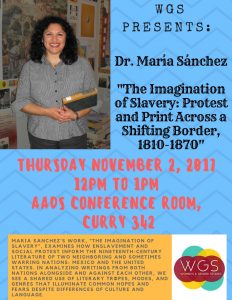Posted on 11/02/2017
 Maria Sanchez’s work, The Imagination of Slavery, examines how enslavement and social protest inform the nineteenth-century literature of two neighboring and sometimes warring nations: Mexico and the United States. In analyzing writings from both nations alongside and against each other, we see a shared use of literary tropes, modes, and genres that illuminate common hopes and fears despite differences of culture and language. Likewise, the enormous political and emotional power of slavery as an institution comes into view as both land and words, from Texas to California, transform into states and literature. In focusing on slavery, Sanchez illuminates how Mexican and U.S. writers understood what was, to them, a living and breathing entity: Slavery’s reach, its futures, its real and potential subjects, and blatant efforts during the nineteenth century to (re)establish it in Spanish-speaking territories where it had been abolished. Slavery was a lived experience, and it was also a threat, a weapon of oppression delicately assembled from kinetic elements of racial identity, national definition, territorial battle, and imperial ambition. Both Mexico and the United States fought wars in which slavery, as a supreme signifier of “inhumane” and “unnatural” social relations, distinguished sides, causes, and visions of nation. Almost at the exact midpoint of the century, Mexico and the United States fought each other. Just as their citizenries went to war, so did their “print cultures,” from novels and newspapers to political declarations posted in town squares. Yet, these disparate peoples fought with very similar weapons of verse and prose. How does one fight a war with words from two languages? How does one fight slavery across a border that will not stay put?
Maria Sanchez’s work, The Imagination of Slavery, examines how enslavement and social protest inform the nineteenth-century literature of two neighboring and sometimes warring nations: Mexico and the United States. In analyzing writings from both nations alongside and against each other, we see a shared use of literary tropes, modes, and genres that illuminate common hopes and fears despite differences of culture and language. Likewise, the enormous political and emotional power of slavery as an institution comes into view as both land and words, from Texas to California, transform into states and literature. In focusing on slavery, Sanchez illuminates how Mexican and U.S. writers understood what was, to them, a living and breathing entity: Slavery’s reach, its futures, its real and potential subjects, and blatant efforts during the nineteenth century to (re)establish it in Spanish-speaking territories where it had been abolished. Slavery was a lived experience, and it was also a threat, a weapon of oppression delicately assembled from kinetic elements of racial identity, national definition, territorial battle, and imperial ambition. Both Mexico and the United States fought wars in which slavery, as a supreme signifier of “inhumane” and “unnatural” social relations, distinguished sides, causes, and visions of nation. Almost at the exact midpoint of the century, Mexico and the United States fought each other. Just as their citizenries went to war, so did their “print cultures,” from novels and newspapers to political declarations posted in town squares. Yet, these disparate peoples fought with very similar weapons of verse and prose. How does one fight a war with words from two languages? How does one fight slavery across a border that will not stay put?
When: Nov 02, 12:00 pm - 1:00 pm
Location: AADS Conference Room, Curry 342